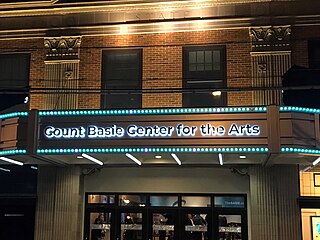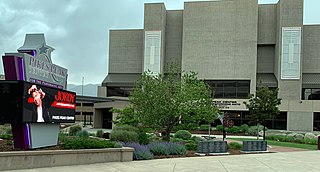
The Fox Theatre is a performing arts center located at 2211 Woodward Avenue in Downtown Detroit, Michigan, near the Grand Circus Park Historic District. Opened in 1928 as a flagship movie palace in the Fox Theatres chain, it was at over 5,000 seats the largest theater in the city. Designed by theater architect C. Howard Crane, it was listed on the National Register of Historic Places in 1985.

The David H. Koch Theater is a theater for ballet, modern and other forms of dance, part of the Lincoln Center, at the intersection of Columbus Avenue and 63rd Street in the Lincoln Square neighborhood of Manhattan in New York City. Originally named the New York State Theater, the venue has been home to the New York City Ballet since its opening in 1964, the secondary venue for the American Ballet Theatre in the fall, and served as home to the New York City Opera from 1964 to 2011. The theater occupies the south side of the main plaza of Lincoln Center, opposite David Geffen Hall.
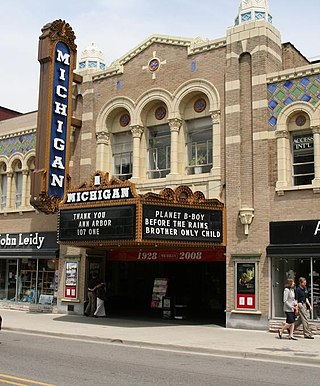
The Michigan Theater is a movie palace in Ann Arbor, Michigan, United States, near the Central Campus of the University of Michigan. It shows independent films and stage productions, and hosts musical concerts.

The Jesse H. Jones Hall for the Performing Arts is a performance venue in Houston, Texas, and the permanent home of the Houston Symphony Orchestra and Society for the Performing Arts. Jones Hall is also frequently rented as a venue for contemporary pop musicians and other performers and is estimated to draw over 400,000 audience members yearly.

The Fox Theater in Spokane, Washington is a 1931 Art Deco movie theater that now serves as a performing arts venue and home of the Spokane Symphony. It was designed by architect Robert C. Reamer, notable for his design of the Old Faithful Inn in Yellowstone National Park. It was part of the Fox Film Corporation Empire founded by studio mogul William Fox. The theater opened September 3, 1931 and showed films continuously until it closed September 21, 2000 after an engagement of the movie Gladiator starring Russell Crowe.

Proctor's Theatre is a theatre and former vaudeville house located in Schenectady, New York, United States. Many famous artists have performed there, including Mariah Carey, Britney Spears, Hal Holbrook, Ted Wiles, and George Burns, as well as many others. It has one of the largest movie screens in the Northeast.

An atmospheric theatre is a type of movie palace design which was popular in the late 1920s. Atmospheric theatres were designed and decorated to evoke the feeling of a particular time and place for patrons, through the use of projectors, architectural elements and ornamentation that evoked a sense of being outdoors. This was intended to make the patron a more active participant in the setting.

The Palace Theatre is an entertainment venue in downtown Albany, New York, located on the corner of Clinton Avenue and North Pearl Street. The theatre is operated by the Palace Performing Arts Center, Inc - a 501(c)(3) non-profit organization. Established in 1984 and incorporated as a not-for-profit corporation in 1989, the Palace Performing Arts Center, Inc. was created to operate the theatre and utilize its full potential as a cultural and entertainment center in Albany.
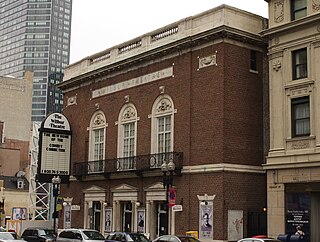
The Wilbur Theatre is a historic performing arts theater at 244–250 Tremont Street in Boston, Massachusetts. The Wilbur Theatre originally opened in 1914, but underwent renovations in 2008. The Wilbur Theatre sits in the heart of Boston's historic theater district and is known for hosting live comedy and music.
The Emery Theatre, or Emery Auditorium, is a historic, acoustically exceptional theater located in the Over-the-Rhine neighborhood of Cincinnati, Ohio. The building was constructed in 1911 as the home for a trade school, but its large, impressive auditorium was intended for public use. The design of the Emery Theatre is based on the "isacoustic curve" principles that were first proposed by John Scott Russell. The theatre was built with two balconies and a total of 2,211 seats. It was one of the first concert halls in the United States to have no obstructed seats.
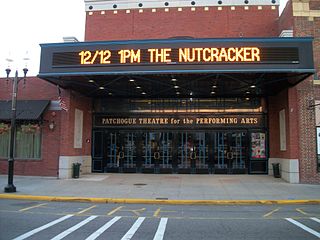
Patchogue Theatre for the Performing Arts is Located at 71 East Main Street in Patchogue Village, Suffolk County, New York.

The Majestic Theatre is a performing arts theater in the City Center District of Downtown Dallas. It is the last remnant of Theater Row, the city's historic entertainment center on Elm Street, and is a contributing property in the Harwood Street Historic District. The structure is a Dallas Landmark and is listed on the National Register of Historic Places.

The Mount Baker Theatre is a 1,517-seat performing arts venue and national historic landmark in Bellingham, Washington, United States. The theater hosts professional productions and concerts as well as community performances from the north of Puget Sound. The theater's main stage is the largest theatrical venue in Washington north of Seattle's Paramount and 5th Avenue.

The Julie Rogers Theatre is a historic performing arts theatre located on Pearl Street in downtown Beaumont, Texas. Built in 1928, the theatre was once Beaumont's City Hall and Auditorium. The capacity is approximately 1,663 seats.
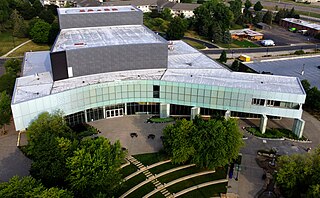
The Ames Center, formerly the Burnsville Performing Arts Center, is a performing arts venue in Burnsville, Minnesota, adjacent to Nicollet Commons Park, which features green space, water fountains, and a 250-seat outdoor performance amphitheater. The Ames Center features an eclectic range of performances on the main stage and the black box theatres including: dance, theatre, concerts, comedians, and written word. Past performances include the Girl Singers of the Hit Parade, Larry Carlton, Louie Anderson, Lori Lane, Richard Marx, Church Basement Ladies, Melissa Manchester, Bill Engvall, Nick Colionne, Celtic Crossroads, Twin Cities Ballet of Minnesota, Elizabeth Gilbert, Rob Lake, Tommy Emmanuel, Sinbad, Ralphie May, Dakota Valley Symphony, Chameleon Theater Circle, Miss Minnesota USA/Teen USA, and Cirque D’Or. Additionally, productions of Mame, A Christmas Carol and Peter Pan were presented utilizing sets created for the Kennedy Center, the Kodak Theatre and the original Cathy Rigby Broadway production respectively.














